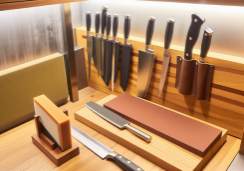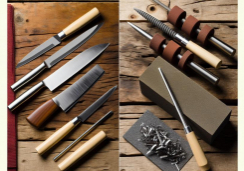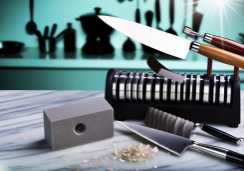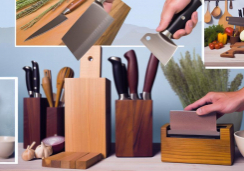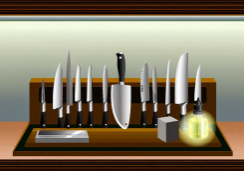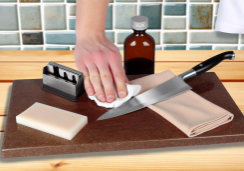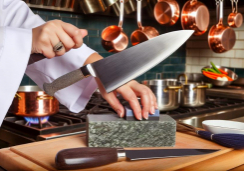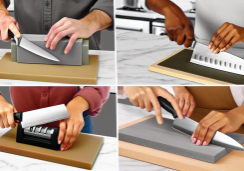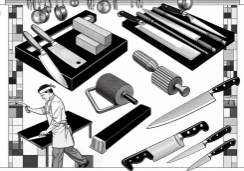Essential Tips for Durable Kitchen Knife Care
Just as Excalibur was only as mighty as the arm that wielded it, your kitchen knives' performance is deeply intertwined with the care you provide them. You've invested in a high-quality set, and it's crucial to maintain that edge.
Let's talk about how you can protect your culinary allies with the right sharpening tools—those that match the steel of your blades without causing undue wear.
You'll also need to master the art of cleaning your knives properly; dishwasher cycles and abrasive sponges are more foe than friend.
And when it comes to storage, there's a method to the madness, ensuring your knives don't dull or damage prematurely.
With proper honing techniques, you'll keep the edge sharp and ready for action.
But how exactly do you combine these elements to extend the life of your knives? Stay with us to uncover the intricacies of knife care that will elevate your cooking experience and safeguard your investment.
Selecting the Right Sharpener
Choosing the appropriate sharpener is crucial to maintaining your kitchen knives' edge and ensuring their longevity. You've got to be meticulous when selecting a sharpener, as the wrong choice can damage the blade. There are two main types you'll encounter: manual and electric sharpeners.
Manual sharpeners are portable and generally less expensive. They require a bit more skill and patience but offer you greater control over the sharpening process. You'll find options like whetstones, which are ideal for precision sharpening, and handheld sharpeners that are great for quick touch-ups.
Electric sharpeners, on the other hand, are fast and user-friendly. They do most of the work for you, using abrasive wheels to sharpen knives quickly. However, they're pricier and can be less forgiving if you're not careful. It's essential to use them with caution to avoid removing too much metal from your blades.
Proper Washing Techniques
To maintain your knives' sharpness and prevent damage, it's essential to master the proper technique for washing them by hand. Start by using warm, not hot, water and a mild dish soap. Hot water can weaken the metal and handle materials, leading to premature wear. Gently clean the blade with a soft sponge, avoiding abrasive scrubbers that can scratch the surface or dull the edge.
After washing, rinse the knife immediately with warm water. Ensure you remove all soap residues, as these can cause corrosion over time. When rinsing, point the blade edge away from you to minimize the risk of cuts. Handle the knife carefully, taking care not to bang the blade against the sink or other hard surfaces, which can cause nicks or misalignment.
Once rinsed, dry your knife thoroughly with a soft towel. Dampness can lead to rust, especially on carbon steel knives, which are more prone to oxidation. Don't let knives air dry, as this increases the potential for rust spots to develop. Instead, store your knife in a block, on a magnetic strip, or in a sheath to protect its edge and ensure it's ready for your next culinary task.
Honing for Edge Maintenance
Regularly honing your knives with a steel rod realigns the blade's edge, ensuring peak performance and longevity. It's a simple process, but it's critical to maintaining a sharp edge between professional sharpenings. Remember, honing isn't the same as sharpening; it refines the edge without removing significant amounts of metal.
Here's how you'll master the art of honing:
- Hold the honing steel vertically with the tip resting on a non-slip surface.
- Your grip should be firm on the handle, with your fingers safely away from the rod's path.
- Place the heel of the knife against the top of the steel at a 15 to 20-degree angle.
- This angle is crucial for effectiveness; too steep can damage the edge, too shallow won't realign it properly.
- With light pressure, slide the blade down the steel, pulling it through from heel to tip.
- Repeat this motion 5 to 10 times on each side of the blade.
Regular honing maintains the edge for longer periods, meaning less frequent sharpening. Your knives will perform better, making your prep work faster and more enjoyable.
Storing Knives Safely
After honing your knives to perfection, it's essential to store them correctly to ensure their edges remain sharp and they're safely out of harm's way. A magnetic strip mounted on the wall is a stylish and accessible solution. It holds knives securely through magnetic force, keeping blades exposed and preventing dulling that occurs when edges touch other surfaces. However, ensure it's installed away from children's reach and isn't where you might accidentally brush against the blades.
Alternatively, consider a knife block, but opt for one with horizontal slots. Vertical slots can dull knife edges as they slide in and out. A wooden block also absorbs moisture, which helps prevent rust and bacteria growth.
For the safest option, particularly if you have curious children, a locked drawer with a knife organizer is ideal. This not only keeps knives out of sight but also organized, with each knife resting in its designated slot, preventing blade damage.
Handling and Usage Best Practices
Handle your knives with care, ensuring you use the correct knife for its intended task to maintain sharpness and prevent damage. Knives are designed with specific purposes in mind, and using them appropriately is crucial for their longevity.
- Choose the Right Knife
- *For chopping vegetables*: Use a chef's knife to ensure clean cuts.
- *For delicate tasks*: Opt for a paring knife when peeling or dicing small items.
Proper Cutting Technique
- *Use a suitable surface*: Always cut on a wooden or plastic cutting board, never on glass or stone.
- *Cut in the right direction*: Slice down and away from your body, keeping fingers clear of the blade.
How Do the Tips for High-Carbon Steel Knife Care Differ from the General Tips for Kitchen Knife Care?
When it comes to highcarbon steel knife care, the tips differ from general kitchen knife care. Highcarbon steel blades require more frequent sharpening and should be dried immediately after washing to prevent rust. They also benefit from oiling to maintain their edge and prevent corrosion.
Conclusion
In conclusion, ensure your kitchen knives remain in top condition by following these essential care tips:
- Choose the appropriate sharpener for your knives.
- Employ correct washing methods.
- Regularly hone the edges.
Store them safely to prevent damage and always adhere to best practices when handling and using them.
By doing these things, you'll not only extend the life of your knives but also maintain their performance, making your culinary endeavors both safer and more enjoyable.
Treat your knives well, and they'll return the favor.

